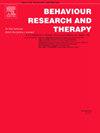使用死亡/自杀内隐关联任务前瞻性预测高风险退伍军人近期自杀行为。
IF 4.5
2区 心理学
Q1 PSYCHOLOGY, CLINICAL
引用次数: 0
摘要
自杀未遂或因自杀行为住院治疗后的90天是精神病患者风险增加的时期。然而,预测有自杀风险的患者中谁会在这段时间内做出自杀行为仍然是一项难以捉摸的任务。神经认知任务表现,如在死亡/自杀内隐联想任务(D/S IAT)中的表现,显示出在临床实践中常规评估的风险因素(如自我报告的自杀意念)之外,帮助预测自杀行为的一些希望。本研究考虑了D/S IAT的表现是否可以在90天内预测自杀行为。60名自杀风险高的退伍军人在一年的时间里在多个时间点完成了D/S IAT测试。然后根据参与者在测试后90天内是否表现出自杀行为,对每个测试阶段进行编码。作为次要目的,漂移扩散模型(DDM)被用来估计潜在的认知过程介导的D/S IAT性能,包括决策效率。采用广义估计方程(GEE)方法的两种应用来评估(1)D/S IAT性能和(2)ddm衍生的潜在变量对预测90天自杀行为的增量效用,这些潜在变量高于标准自杀危险因素,包括自杀企图史、重度抑郁症或双相情感障碍,以及在测试时的自杀意念。考虑到年龄对反应时间和D/S IAT性能的影响,年龄也被包括在模型中。随着将自我概念与生命概念相联系的内隐偏见减弱,90天内自杀行为的几率显著增加。将生命概念与死亡分类为“像我一样”的决策效率降低的潜在认知过程预测了90天内的自杀行为。D/S IAT表现可能会增加近期自杀行为的预测。决策效率降低是一个普遍的认知因素,与自杀行为有关。本文章由计算机程序翻译,如有差异,请以英文原文为准。
Using the death/suicide implicit association task to prospectively predict near-term suicidal behavior in high-risk veterans
The 90-day period after a suicide attempt or hospitalization for suicidal behavior is a period of increased risk for psychiatric patients. However, predicting who among patients at suicide risk will engage in suicidal behavior in this window remains an elusive task. Neurocognitive task performance, such as performance on the Death/Suicide Implicit Association Task (D/S IAT), shows some promise for aiding in the prediction of suicidal behavior beyond risk factors routinely assessed in clinical practice, such as self-reported suicidal ideation. This study considered whether performance on the D/S IAT could prospectively predict suicidal behavior within a 90-day window. Sixty Veterans at high risk for suicide completed the D/S IAT at multiple timepoints over a one-year period. Each testing session was then coded according to whether the participant displayed suicidal behavior within 90 days following that testing session. As a secondary aim, drift diffusion modeling (DDM) was used to estimate latent cognitive processes mediating D/S IAT performance, including decisional efficiency. Two applications of the Generalized Estimating Equations (GEE) method were used to evaluate the incremental utility of (1) D/S IAT performance and (2) DDM-derived latent variables on predicting 90-day suicidal behavior over standard suicide risk factors including suicide attempt history, major depressive or bipolar disorder, and suicidal ideation at the time of testing. Age was also included in the models given the impact of age on reaction times and thus D/S IAT performance. The odds of 90-day suicidal behavior were significantly increased as implicit bias linking the self-concept to the concept of life as opposed to death weakened. The latent cognitive process of reduced decisional efficiency towards categorizing the concept of life relative to death as “like me” predicted 90-day suicidal behavior. D/S IAT performance may add to near-term suicidal behavior prediction. Reduced decisional efficiency is emerging as a general cognitive factor implicated in suicidal behavior.
求助全文
通过发布文献求助,成功后即可免费获取论文全文。
去求助
来源期刊

Behaviour Research and Therapy
PSYCHOLOGY, CLINICAL-
CiteScore
7.50
自引率
7.30%
发文量
148
期刊介绍:
The major focus of Behaviour Research and Therapy is an experimental psychopathology approach to understanding emotional and behavioral disorders and their prevention and treatment, using cognitive, behavioral, and psychophysiological (including neural) methods and models. This includes laboratory-based experimental studies with healthy, at risk and subclinical individuals that inform clinical application as well as studies with clinically severe samples. The following types of submissions are encouraged: theoretical reviews of mechanisms that contribute to psychopathology and that offer new treatment targets; tests of novel, mechanistically focused psychological interventions, especially ones that include theory-driven or experimentally-derived predictors, moderators and mediators; and innovations in dissemination and implementation of evidence-based practices into clinical practice in psychology and associated fields, especially those that target underlying mechanisms or focus on novel approaches to treatment delivery. In addition to traditional psychological disorders, the scope of the journal includes behavioural medicine (e.g., chronic pain). The journal will not consider manuscripts dealing primarily with measurement, psychometric analyses, and personality assessment.
 求助内容:
求助内容: 应助结果提醒方式:
应助结果提醒方式:


